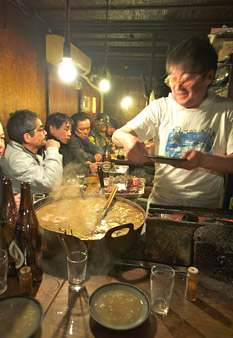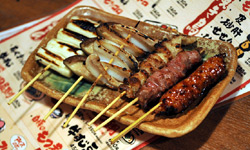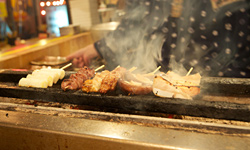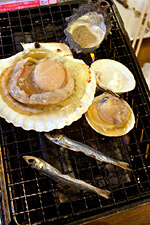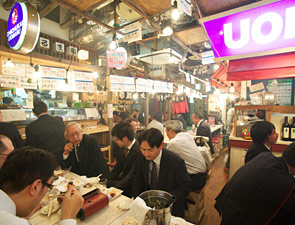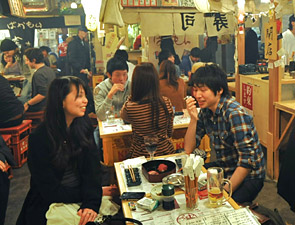Web Japan > Trends in Japan > Tech & Life > Yokocho
Yokocho
Japan's Little Drinking Districts Offer a Taste of Nostalgia
In Japanese, yokocho literally means "alleyways off to the side of a main street." But it can also refer to the small pubs and bars that are often adjoined in rows along these narrow lanes. Little yokocho areas can be found in cities all over Japan, and as one would expect, they are especially common in the big cities of Tokyo and Osaka. In Tokyo, for example, the Omoide Yokocho [Yokocho of Memories] in Shinjuku, Nonbei Yokocho [Drunkard's Yokocho] in Shibuya, and Harmonica Yokocho in Kichijoji are well known as historical spots, having originated as marketplace shacks that were built after much of the city was destroyed in World War II. Yokocho establishments have been especially popular with middle-aged and older men.
When walking past the small and tightly packed shopfronts in a yokocho area, you may feel like you have traveled back in time. A folksy and open atmosphere spills out from the pubs and bars, where new companions sit shoulder-to-shoulder inside, and customers and staff converse freely and casually. Aromatic smoke and steam flow outside from giant pots of motsuni, or stewed beef and chicken entrails, and grills cooking up yakitori, or skewered chicken. These are all are standard menu items that have satisfied customers' appetites since the early days of yokocho.
Yokocho Change with the Times to Attract Younger People and Women
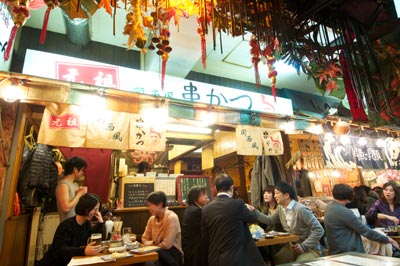
Popular with the younger set, the Ebisu Yokocho is relatively new, but its atmosphere offers the nostalgic charm of days gone by.
Enlarge photoRecently, yokocho have come under a new, modern spotlight, and these districts are experiencing something of a boom. Traditional customers at popular yokocho pubs are no longer mostly middle-aged and older gentlemen—young people and women are now a common sight. Among the reasons for this new popularity are the reasonably priced drinks and food that can be enjoyed, and menus have expanded to include a variety of dishes besides motsuni and yakitori. But that's not all: people are attracted to the cozy atmosphere where they can enjoy friendly conversations with other customers and staff.
Perhaps visiting yokocho offers young people and women a chance to enjoy a break from the monotony of everyday life and directly experience the sentiments and warm-heartedness of the past. Now it is not rare to see groups of young ladies popping into yokocho pubs and bars. Yokocho areas are even becoming quite popular among tourists from overseas as places to really experience the ordinary life and generous spirit of the Japanese.
Handing Down the Pleasures of Yokocho to a New GenerationAlong with these changing trends, ambitious efforts to create entirely new yokocho have been underway recently. In 2008, for instance, Ebisu Yokocho opened as a yokocho-styled bar and restaurant district completely remodeled in what was previously a run-down public market in Tokyo's Ebisu area. With interiors designed to create a retro look, the bars and pubs offer customers a truly nostalgic experience, and the lively energy in this yokocho creates a welcoming atmosphere for women and the younger generation.
In similar fashion, 2009 saw the opening of the Shinagawa Gyokai Center [Shinagawa Seafood Center], made up exclusively of pubs serving seafood, and the Shibuya Niku Yokocho [Shibuya Meat Yokocho], featuring an assortment of barbecued meat restaurants. The establishment of yokocho districts based on themes like these is a recent trend.
In this way, new yokocho districts in the 21st century are evolving along modern lines. Indeed, it looks as though the pleasures offered by yokocho establishments, where people can unwind together and reminisce on fond memories, will most certainly be passed on to future generations. (March 2012)
- B-Grade Cuisine Gets an "A" for Taste (January 2010)
- Home-Grown Cuisine (December 2008)

